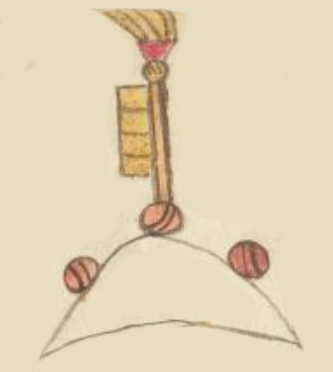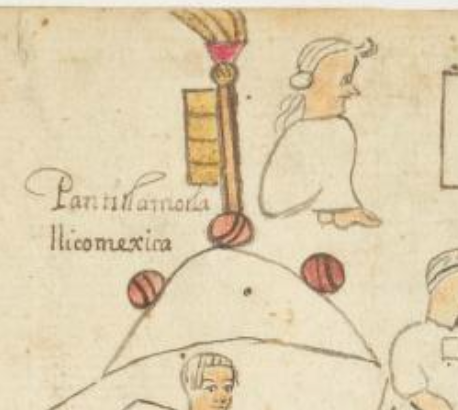Pantitlan (Azca15)
This painted black-line drawing of the compound glyph for the place name Pantitlan (“Near the Flag” or “Near the Flags’) shows a frontal view of a smooth white hill or mountain (tepetl) with three stones (tetl) distributed along its crest. These stones all have a stripe through the middle, and they are all painted red. The highest stone has a vertical flag on a flagpole emerging from it. The pole is red, while the flag, flying to the left, is painted gold or yellow. The flag has three horizontal lines that divide it into four segments. The flag pole has a round object at the top, and above that is what appears to be a red fan base with perhaps three golden feathers rising from it.
Stephanie Wood
The hill or mountain that provides the key landscape element for this settlement is unusual in not having curling rocky outcroppings, but rather, relatively small round stones distributed along the top of it.
Stephanie Wood
Pantitla
Pantitlan
Stephanie Wood
post-1550, possibly from the early seventeenth century.
Jeff Haskett-Wood
banderas, piedras, montañas, cerros, pueblos, topónimos, nombres de lugares

pan(itl) or pam(itl), flag, https://nahuatl.wired-humanities.org/content/panitl
-titlan, (locative suffix), next to, https://nahuatl.wired-humanities.org/content/titlan
Cerca de la Bandera, o Cerca de las Banderas
Stephanie Wood
The Codex Azcatitlan is also known as the Histoire mexicaine, [Manuscrit] Mexicain 59–64. It is housed in the Bibliothèque Nationale de France, and hosted on line by the World Digital Library and the Library of Congress, which is “unaware of any copyright or other restrictions in the World Digital Library Collection.”
https://www.loc.gov/resource/gdcwdl.wdl_15280/?sp=15&st=image
The Library of Congress is “unaware of any copyright or other restrictions in the World Digital Library Collection.” But please cite Bibliothèque Nationale de France and this Visual Lexicon of Aztec Hieroglyphs.


